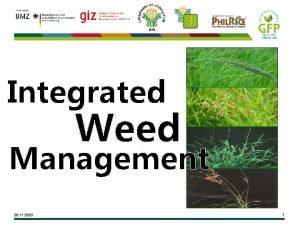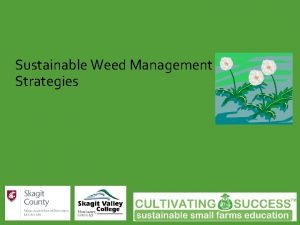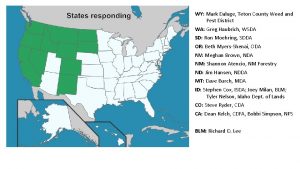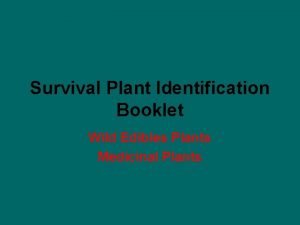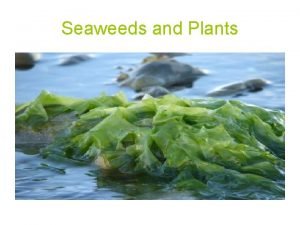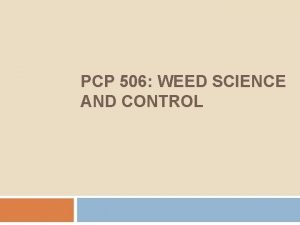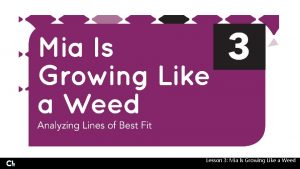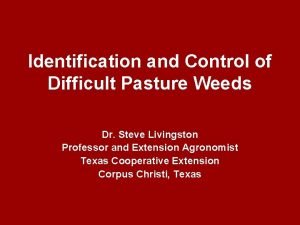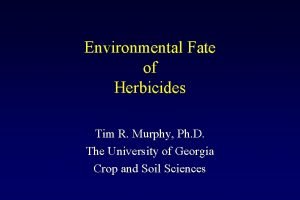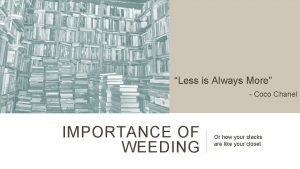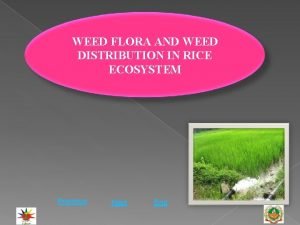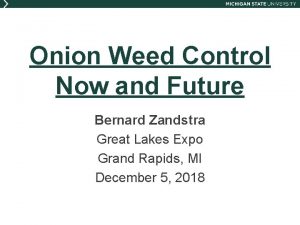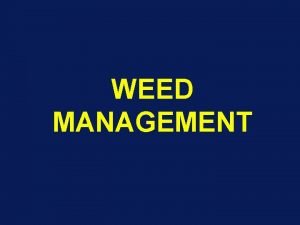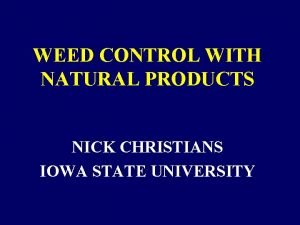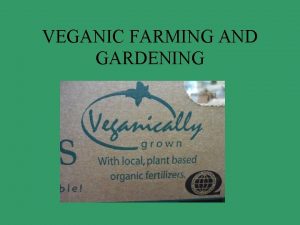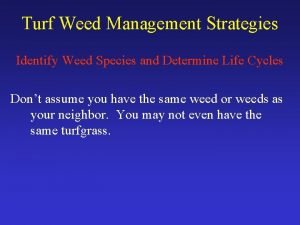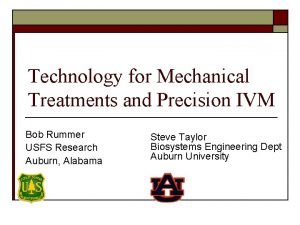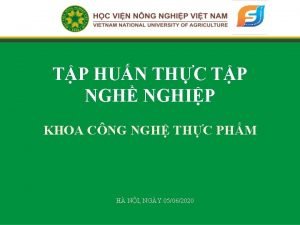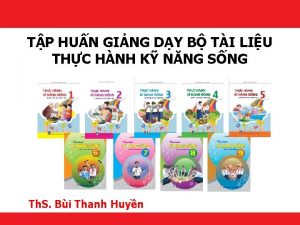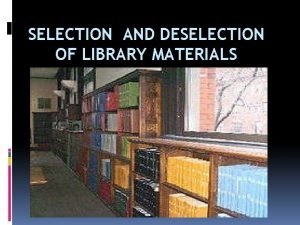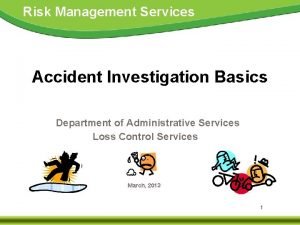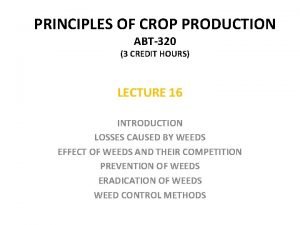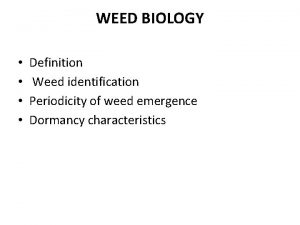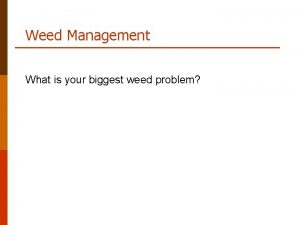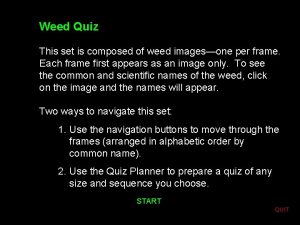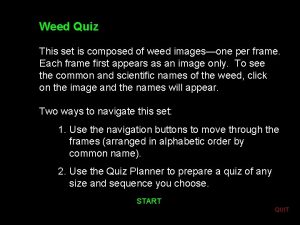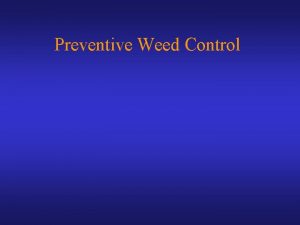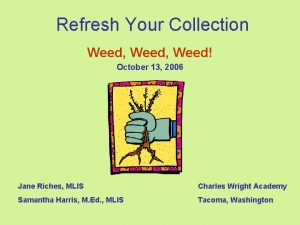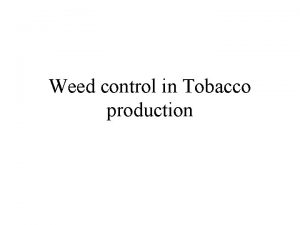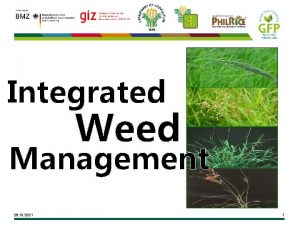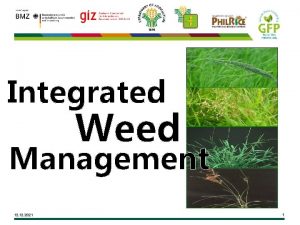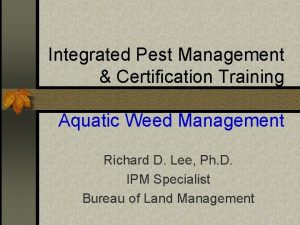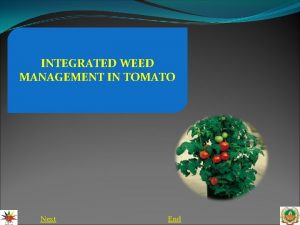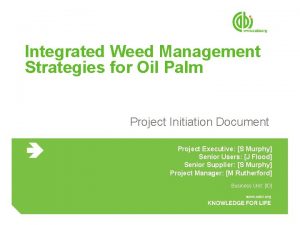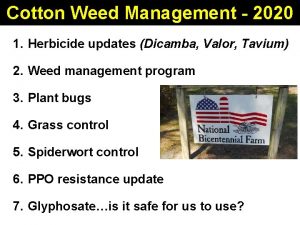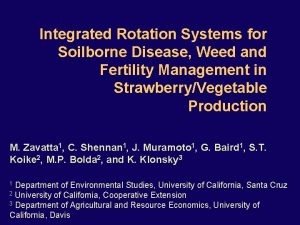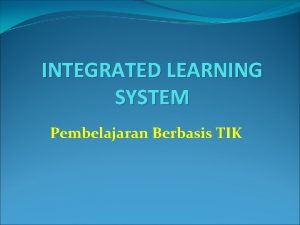Integrated Weed Management 26 11 2020 1 Learning































- Slides: 31

Integrated Weed Management 26. 11. 2020 1

Learning Objectives: • Explain the harmful effects of weeds on rice plants; • Differentiate the general types of weeds based on their morphology, life cycle and habitat; • Discuss the importance of integrated weed management (IWM); • Explain the general principles of IWM; • Enumerate the components of IWM; and • Cite the advantages and disadvantages of using herbicides 26. 11. 2020 2

Structure: • Integrated Weed Management (IWM) • General types of weed based on morphology, life cycle and habitat • Importance and general principles of IWM • Components of IWM • Advantages and disadvantages of using herbicides 26. 11. 2020 3

Losses due to weeds Compared to other pest problems in rice in the World § § § Losses to weeds = Insects = Diseases = 30 % (Oerke et al. 1995) 14. 6 % 16 % “ “ Order of magnitude of yield loss due to weeds in rice: § Transplanted rice < wet direct-seeded rice < dry direct-seeded rice < upland rice 26. 11. 2020 4

“Rule of thumb” (Zimdhal, 1980) For every unit of biomass of the weed, the yield of the crop is reduced by a similar amount. 1 kg of weeds = less 1 kg of yield 26. 11. 2020 5

What is Integrated Weed Management (IWM)? It is the best mix of several weed management strategies, direct and indirect, environmentally sound, and socially acceptable. 26. 11. 2020 6

Definition of Weeds • Plant growing where it is not desired/ out of place • Plant that interferes with man or area of his interest • Plant whose desirable features outweigh its desirable features 26. 11. 2020 7

What is the problem with weeds? • Compete with crops causing yield reduction • Affect quality of agricultural produce • Harbor pest/alternate hosts 26. 11. 2020 8

Activity 26. 11. 2020 9

General types of weeds A. Morphology Grass v long narrow leaves v parallel veins v round hollow stems v prominent nodes and internodes v alternate leaf arrangement 26. 11. 2020 10

Sedge v long narrow leaves v no nodes and internodes v solid and triangular stems v 3 ranks or in rosette leaf arrangement 26. 11. 2020 11

Broad leaf v leaf blades larger than those of grass and sedge v leaf of various shapes and netted veins 26. 11. 2020 12

26. 11. 2020 13

B. Life Cycle Annual-complete their life cycle within 1 year or less Perennial-complete their life cycle for more than 1 year 26. 11. 2020 14

C. Habitat Aquatic-weeds that live in water. They are either submerged or floating. Upland-weeds that live in well-drained soil condition. 26. 11. 2020 15

General principles of IWM v The major purpose of weed management is to reduce weed populations to levels that do not significantly reduce crop yields. v Control measures should effectively kill seeds, seedlings, and vegetative propagules of weeds. 26. 11. 2020 16

v Start weed suppression activities early in the season, and sustain these until the crop leaf canopies close in. v The choice of control measure is influenced by the expected or existing weed species, cost, availability of control inputs, crop culture, and safety to nontarget organisms. 26. 11. 2020 17

Components of IWM Preventive method v use of certified seeds v proper management of implements and livestock v keeping bunds and irrigation canals free from weeds 26. 11. 2020 18

Cultural and ecological method v involves alteration of growing conditions aimed at indirectly suppressing weed populations by decreasing competitive ability v directly suppressing weed population by encouraging weed growth at specified periods during which direct control methods can be applied. v ex. Land preparation, water mgt. , method of planting 26. 11. 2020 19

Land preparation v suppress weeds by deep plowing, puddling, increased tillage and timing of land preparation v soil must be soft and saturated 26. 11. 2020 20

Water management v In transplanted rice, 2 -3 cm water level at 3 -4 DAT v In direct-seeded, 3 -5 cm water level at 710 DAS 26. 11. 2020 21

Physical method Hand weeding v Oldest, simplest and most direct way of controlling weeds. v Should be done early in the crop’s growth since more labor is needed as the crop develops. 26. 11. 2020 22

Mechanical method Rotary weeding v applicable in straight row transplanted rice v spacing must not be closer than 20 x 20 cm v soil must be soft and saturated 26. 11. 2020 23

Chemical Method v Chemical used to kill or prevent growth of weeds. v. For a successful and economical use, it is important to understand how these chemicals work and their limitations. 26. 11. 2020 24

Management of weeds for transplanted rice v Plow the field to incorporate weeds left from the previous crop or fallow period into the soil. v Puddle the soil and harrow 3 -4 times to destroy weeds not killed by plowing. v Transplant seedlings not be closer than 20 x 20 cm. v Level the field so that uniform flooding and water depth can be maintained. 26. 11. 2020 25

v If water is available, flood the field 2 -3 days after transplanting and maintain 5 -10 cm of standing water continuously throughout the season. v For severe weed problems, additional weed control methods may be necessary. v Control weeds before applying fertilizer so that the crop benefits and weed growth is not stimulated. 26. 11. 2020 26

Application of herbicide v Herbicide use requires adequate knowledge and skills. v. Careless herbicide application may result to inadequate weed control and damage or it may completely kill the crop. 26. 11. 2020 27

Advantages and disadvantages of using herbicides v Applying herbicides saves labor. v Herbicides can be used in all environments. v The continued use of the same herbicide leads to a build-up of weeds resistant to the herbicide. 26. 11. 2020 28

Advantages and disadvantages of using herbicides v To prevent this build-up, rotate crops, change herbicides and use several control methods together. v. The best way to prevent the build-up of weeds tolerant to herbicides is to periodically remove them by hand or mechanical weeding. 26. 11. 2020 29

Remember, improper herbicide use such as using the wrong herbicide, applying too much or applying at the wrong time causes injury to the rice plant. 26. 11. 2020 30

Thank you!!! 26. 11. 2020 31
 Advantages of integrated weed management
Advantages of integrated weed management Sustainable weed management
Sustainable weed management Cuadro comparativo e-learning b-learning m-learning
Cuadro comparativo e-learning b-learning m-learning Fly control teton county
Fly control teton county Jewel weed medicinal
Jewel weed medicinal Is sea weed a plant
Is sea weed a plant Allelospoly
Allelospoly Mia's growing like a weed answers
Mia's growing like a weed answers Weed science definition
Weed science definition Sniffable weed
Sniffable weed What is this weed
What is this weed Weed control murphy
Weed control murphy Accident weed diagram
Accident weed diagram Negative effects of weed on teenage brain
Negative effects of weed on teenage brain Less is more coco chanel
Less is more coco chanel Harmful effects of weeds
Harmful effects of weeds Cannabis pesticides
Cannabis pesticides Mayil kondai weed
Mayil kondai weed Onion weed in lakes
Onion weed in lakes Alien weed definition
Alien weed definition Economic importance of weed
Economic importance of weed Corn weed blocker
Corn weed blocker Veganic weed
Veganic weed Sandspur removal kit
Sandspur removal kit Weed wrench
Weed wrench Mary jane herb
Mary jane herb Weed hun
Weed hun Weed hun
Weed hun Selection and deselection
Selection and deselection Accident weed
Accident weed Biological method of weed control
Biological method of weed control Datura stramonium
Datura stramonium
